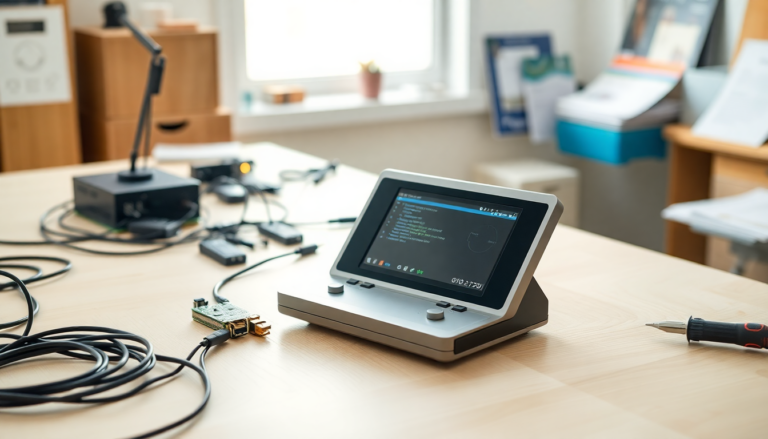Argomenti trattati
Introducing the OneChipBook-12
The OneChipBook-12 from 8086YES! may initially resemble a vintage netbook, but it is, in fact, a feature-rich FPGA development platform powered by the Cyclone EP1C12Q core. For those who are new to the concept, an FPGA (field-programmable gate array) is a type of integrated circuit that can be reconfigured post-manufacturing. This remarkable flexibility allows it to be adapted thousands of times to create various digital circuits, making it an exceptional tool for learning and experimenting with hardware design.
Specifications and Features
The Altera Cyclone EP1C12Q240 chip integrated into the OneChipBook-12 boasts over 12,000 logic elements and 240kbits of RAM. Complemented by 32MB of SDRAM and an SD card slot supporting FAT16, this device is equipped with sufficient power and versatility for engaging in retro computing projects or educational experiments.
One of the standout features of the OneChipBook-12 is its all-in-one design. Unlike most FPGA development boards that necessitate external peripherals like monitors, keyboards, and power supplies, this device comes fully equipped. It features a 1024×768 LCD panel repurposed from an old iPad 2, paired with a backlit mechanical PS/2 keyboard available in two configurations: a standard layout with function keys and a custom layout designed specifically for MSX-style emulation, which includes KANA and GRAPH keys.
Connectivity and Portability
In terms of connectivity, the OneChipBook-12 does not disappoint. It includes a PS/2 port, dual DB9 joystick ports, and a USB Type-A connection. For video output, users have options such as VGA, S-Video, and composite video, ensuring compatibility with various retro devices. Additionally, the device is equipped with built-in stereo speakers and a 3.5mm headphone jack, complete with a volume knob that enhances its retro charm.
To further extend its capabilities, the OneChipBook-12 comes with a small expansion cartridge slot and a DIP switch for customization. Powering the device is convenient as it utilizes a USB Type-C port and houses an internal lithium battery, making it compact and portable enough to easily fit in a backpack for on-the-go projects.
Where to Buy and Pricing Information
If you’re interested in acquiring the OneChipBook-12, it is available for purchase on platforms like Tindie and eBay for around $215, while AliExpress lists it for approximately $235. While it may not cater to everyone’s needs, it stands out as an appealing option for those seeking a portable FPGA development kit.
Software and Firmware Considerations
It is important to note that the OneChipBook-12 does not come pre-loaded with firmware. However, it includes a USB Blaster for users to upload their custom FPGA cores. As mentioned in various tech forums, the provided PDF documentation contains essential hardware details and general advice on flashing firmware, but it lacks specific instructions for installing MSX firmware, potentially due to legal considerations.
Interestingly, the device was previously marketed under the name MSXBook, a title that has since been abandoned to prevent trademark conflicts. Although the company that produces the OneChipBook-12 has previously offered support, it appears that this is no longer the case. For those seeking additional guidance on firmware flashing, a webpage exists with comprehensive instructions, albeit in Japanese.
Final Thoughts on the OneChipBook-12
In summary, the OneChipBook-12 is a remarkable device that combines retro aesthetics with modern FPGA capabilities, catering to tech enthusiasts and hobbyists alike. Whether you’re looking to delve into hardware design or simply want a nostalgic computing experience, this handheld development kit might just be the perfect fit.

